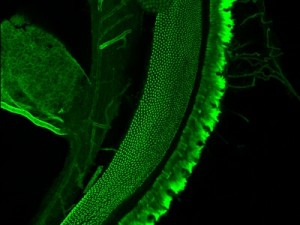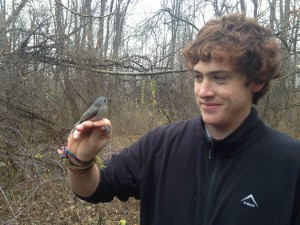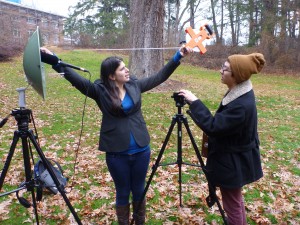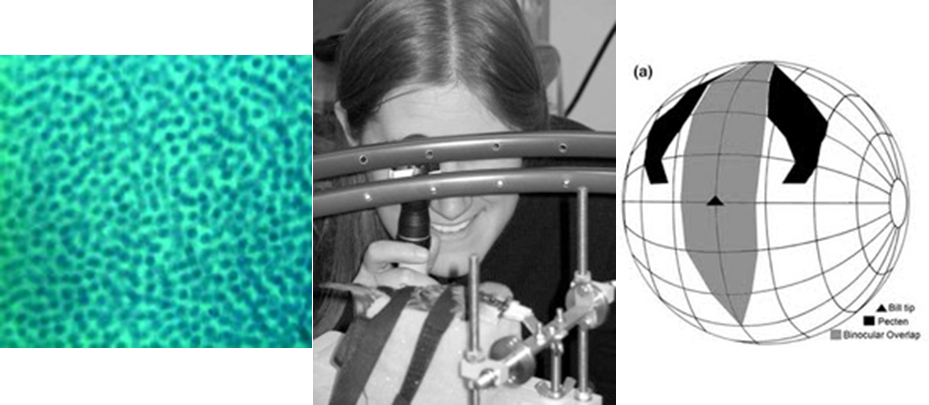New Projects!
Project Chickadee
Black-capped Chickadees ar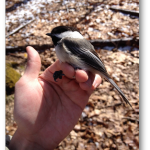 e commonly used as a model system in animal communication. In our lab we are interested in the relationship between the sensory physiology of the chickadees and their behavioral ecology. We have a banded population of over 100 individuals at the Vassar Farm and Ecological Preserve that we use to study auditory processing, vocal production, social interactions, and distribution. This is a long-term project in which we hope to integrate traditional lab-based sensory physiology with the behavior of free-living individuals.
e commonly used as a model system in animal communication. In our lab we are interested in the relationship between the sensory physiology of the chickadees and their behavioral ecology. We have a banded population of over 100 individuals at the Vassar Farm and Ecological Preserve that we use to study auditory processing, vocal production, social interactions, and distribution. This is a long-term project in which we hope to integrate traditional lab-based sensory physiology with the behavior of free-living individuals.
The Saw-whet Project
 Northern Saw-whet Owls are the most common owl in North America. They have an extremely interesting ear morphology that suggests that they are likely to have exquisite hearing. Yet despite all this, there is virtually nothing known about their auditory processing. Here we are collaborating with Dr. Glenn Proudfoot to investigate basic aspects of auditory processing (frequency and temporal sensitivity). We’re currently working on a novel device to study directional sensitivity.
Northern Saw-whet Owls are the most common owl in North America. They have an extremely interesting ear morphology that suggests that they are likely to have exquisite hearing. Yet despite all this, there is virtually nothing known about their auditory processing. Here we are collaborating with Dr. Glenn Proudfoot to investigate basic aspects of auditory processing (frequency and temporal sensitivity). We’re currently working on a novel device to study directional sensitivity.
Deer-browsing and Communication
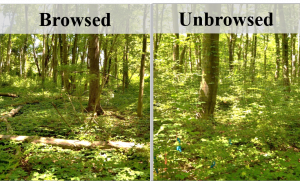 White-tailed deer have dramatically changed both the vegetation structure of temperate forests in the Northeast and avian communities.We have long known that habitat structure has a significant impact on the propagation of both visual and acoustic signals. In this project we are investigating how deer-induced changes in habitat structure may influence communication in songbirds, particularly those that communicate mainly in the understory.
White-tailed deer have dramatically changed both the vegetation structure of temperate forests in the Northeast and avian communities.We have long known that habitat structure has a significant impact on the propagation of both visual and acoustic signals. In this project we are investigating how deer-induced changes in habitat structure may influence communication in songbirds, particularly those that communicate mainly in the understory.
Ongoing Work
Mechanisms Regulating Sensory Plasticity
Many frogs and songbirds are seasonal breeders and the nature of their communicative interactions change seasonally. Individuals are likely to differ in the number and types of communicative interactions they experience, and past communication experience is likely to shape future communicative interactions. For instance, the dear enemy hypothesis predicts that territorial song displays of males are likely to be less intense when an intruder is a neighbor, rather than a stranger. Additionally, in many species males learn the songs of their fathers and females prefer male partners that sing partially similar songs to their fathers. In each of these situations, previous experience with a communication signal alters the behavioral response to that signal in future communicative interactions. Behavioral plasticity induced by experience with communication signals has adaptive value in these cases if it prevents escalation of aggressive encounters or reinforces species or population appropriate reproductive behavior. We are interested in the effects of acoustic experience in shaping peripheral sensory systems and how that plasticity informs behavior. Click on the link above to learn more!
Evolution of Auditory Processing in Songbirds
Peripheral sensory structures (cochlea, auditory nerve, and brainstem) are the first information filtering step for animals and as such are instrumental in determining an animal’s “Umwelt” or worldview. The matched filters hypothesis predicts that peripheral sensory structures will be tuned in a way that optimizes the extraction of species-specific communication signals from environmental noise. This hypothesis has largely been validated in insects and frogs, but it is not clear the extent to which this hypothesis holds in songbirds. Current evidence suggests that species-specific communication signals are likely to explain some of the variance in peripheral sensory processing, but much of the variance (and conversely, conservation) in songbird auditory processing has yet to be explained. Click on the link above to learn more!
Communication and Human Disturbance
Anthropogenic disturbance provides an ideal model system for investigating the effects of the environment on communication. Anthropogenic disturbance can alter both habitat structure and noise profiles of environments, which in turn influence signal propagation. For instance, I have shown that low frequency-elements of brown-headed cowbird song, which are critical for mate selection, are more strongly masked by low frequency noise in urban environments than in non-urban environments. However, high-frequency elements used in male-male communication actually propagate farther in open urban areas, likely due to sound channels created by the hard surfaces of buildings and roadways. There is now a large body of evidence to suggest that song structure is altered in populations exposed to anthropogenic disturbance, either through local adaptation or individual plasticity in song production. We are interested in the effects of anthropogenic disturbance on sensory structures and sensory processing, as well as the effects on multimodal signaling. Click on the link above to learn more!
Previous Work
Black Phoebe Visual Ecology

